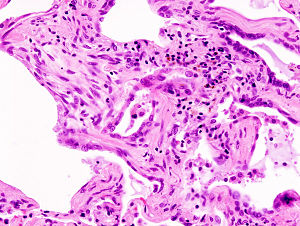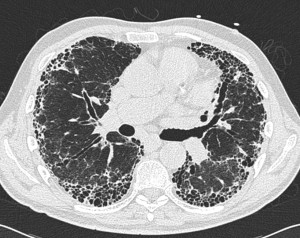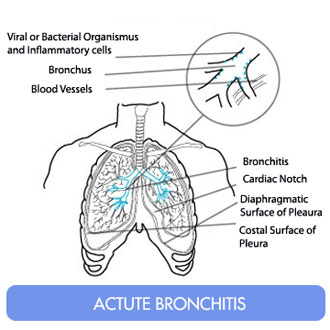As many as 50,000 individuals in the US suffer from Idiopathic Pulmonary Fibrosis (IPF) – an acute respiratory disorder that causes chest pain and dry cough in sufferers without any particular cause. Find out all about this condition, including its causes, symptoms, diagnosis and treatment.
What is Idiopathic Pulmonary Fibrosis?
Page Contents
- 1 What is Idiopathic Pulmonary Fibrosis?
- 2 Idiopathic Pulmonary Fibrosis ICD9 Code
- 3 Idiopathic Pulmonary Fibrosis Synonyms
- 4 Idiopathic Pulmonary Fibrosis Causes
- 5 Idiopathic Pulmonary Fibrosis Risk Factors
- 6 Idiopathic Pulmonary Fibrosis Incidence
- 7 Idiopathic Pulmonary Fibrosis Symptoms
- 8 Idiopathic Pulmonary Fibrosis Diagnosis
- 9 Idiopathic Pulmonary Fibrosis Treatment
- 10 Idiopathic Pulmonary Fibrosis Prognosis
- 11 Idiopathic Pulmonary Fibrosis Life Expectancy
It is a severe respiratory disorder characterized by thickening and damage of the tiny and small air sacs of the lungs (known as alveoli) along with the surrounding tissues. This interstitial lung disease causes complete scarring of the lungs and affects its capability to supply enough oxygen to the body. This ailment usually affects older individuals along with middle aged adults. The intensity of this disease varies from one patient to another.
Idiopathic Pulmonary Fibrosis ICD9 Code
The ICD9 code for this ailment is 516.3.
Idiopathic Pulmonary Fibrosis Synonyms
This progressive lung disease is known by many other names like:
Picture 1 – Idiopathic Pulmonary Fibrosis
- Idiopathic diffuse interstitial pulmonary fibrosis
- Cryptogenic fibrosing alveolitis
- IPF
- CFA
- Pulmonary fibrosis
- Usual interstitial pneumonitis
- UIP
- Fibrosing alveolitis
Idiopathic Pulmonary Fibrosis Causes
Despite extensive medical research and study, the actual cause of this progressive lung disease is still unknown. In a few cases, IPF is supposed to arise due to genetic defects while in other cases it is believed to arise due to factors like:
Diseases
A few disorders and infections can give rise to IPF. These include:
• Grain Handler’s Lung
• Bird Breeder’s Lung
• Hermansky Pudlak Syndrome
• Mushroom Worker’s Lung
• Tuberculosis
• Detergent Worker’s Lung
• Maple Bark Stripper’s Lung
• Rheumatoid Arthritis
• Malt Worker’s Lung
• Systemic Sclerosis
• Bagassosis
• Systemic Lupus Erythematosis
• Paprika Splitter’s Lung
Environment
Certain environmental factors, which can give rise to this disease, include:
- Exposure to cigarette smoke, either directly or indirectly
- Exposure to contaminants, such as organic dusts (namely bacteria and animal proteins) and inorganic dusts(like Beryllium, Asbestos, hard metal dusts and Silica)
Medicines
The side effects arising due to the usage of some medicines can give rise to IPF. These medications include:
- Cyclophosphamide, bleomycin and methotrexate, which are recommended for cancer management.
- Nitiofurantoin, suggested for urinary tract infections
- Amiodarone, used for curing abnormal heart rate
Idiopathic Pulmonary Fibrosis Risk Factors
Certain conditions make an individual more susceptible to this syndrome. These include:
- Smoking
- Direct exposure to fumes, which make dust ranchers, hairdressers and farmers more prone to this infection
- Being male. Men are diagnosed with this disorder more than women.
Idiopathic Pulmonary Fibrosis Incidence
IPF is a very rare disease. Around 3 in 10000 people in the US are affected with this syndrome. Although anyone of any age can be affected with IPF, this disorder mainly affects people aged between 50 and 70 years. Around 50,000 Americans are affected by it and approximately 15,000 new cases of this disease arise each year.
Idiopathic Pulmonary Fibrosis Symptoms
The symptoms initially arising due to this syndrome include problems like shortness of breath, which occur during any type of physical activity. Some patients often complain about a persistent cough, which is mostly dry. These are considered to be the primary symptoms of IPF. However, a person affected with the condition may also experience other problems like:
- Fatigue
- Loss of stamina
- Chest pain
- Uniting of the fingers
- Loss of hunger
- Cyanosis, marked by blue discoloration of lips or nail beds due to inadequate oxygen supply to the tissues
- Weight loss
Idiopathic Pulmonary Fibrosis Diagnosis
Doctors use a number of diagnostic techniques to determine the existence of IPF among patients. The use of such techniques depends on the medical history and the physical condition of individual patients. Certain diagnostic techniques used to test the presence of IPF include:
Physical Examination
Doctors use a stethoscope to examine the breathing of patients. On hearing ‘crackles’ during inspiration they can be sure of the existence of IPF in a patient.
Analysis of Medical History
The medical history of a patient should be thoroughly checked to detect any occupational, environmental, familial or medical condition which might have led to the development of this syndrome.
HRCT
High Resolution Computerized Tomography provides a clear and distinct picture of the lungs. This helps doctors to clearly evaluate the clinical pattern of affected lungs and determine the presence of IPF.
ABG
Arterial Blood Gas examination helps in the correct evaluation of oxygen, arterial pH and carbon dioxide level in the lung via an arterial puncture. The level of oxygen determines the existence of IPF among patients.
X-Ray
A routine examination of the chest can be used as a screening test. It is not possible to diagnose IPF using a chest X-Ray result as most patients with the disorder tend to have a common outcome.
Bronchoscopy
It helps doctors examine various types of lung problems and blockages. It includes the analysis of the central airways of the lungs via a small tubular apparatus known as bronchoscope. However, lung tissue samples obtained through this process are not enough for proper diagnosis.
Surgical Lung Biopsy
It is considered to be one of the best diagnostic tests for suspected IPF patients. A number of lung disorders are quite similar to IPF syndrome. Hence, an accurate diagnosis is essential to ensure proper treatment and better outcome for patients. A proper lung biopsy, in combination with HRCT can easily help evaluate the extent of spread of this disease in the body of a patient.
Pulmonary Function Tests
These are breathing tests which are used to analyze the capability of the lungs to inhale and exhale oxygen and carbon dioxide. There are two vital aspects of such a test:
- Spirometry, which is used to calculate the inhaled and exhaled lung volumes along with the rate in which it takes place.
- Diffusion Capacity, which is used to calculate the capability of oxygen to mix into the blood.
Bronchoalveolar lavage
It is done via bronchoscope and is the only way to eliminate the small cell samplings from the entire respiratory canal. A minimal amount of saline is transferred via bronchoscope into the patient’s body. When pulled back, it removes a small collection of cells from the respiratory canal.
Pulse Oximeter
It is a screening test which shows the amount of oxygen present in blood. An absence of required level of oxygen in blood indicates the presence of IPF in the lungs of a patient.
Exercise testing
It is used to calculate how the lungs react to any physical activity. It generally includes the use of a treadmill or bike. During physical exercise, EKG, blood pressure and oxygen levels are examined accurately.
Idiopathic Pulmonary Fibrosis Treatment
Doctors prescribe a number of treatments for curing this disorder, which include:
Oxygen Therapy
It helps minimize respiratory shortness and make a patient active and energetic once again. This therapy is required even more when the severity of the disease increases.
Medicines
At present, it is not possible to reduce the growth of IPF by using any medication. In many cases, however, N-acetylcysteine, Azathioprine and Prednisone medicines are used to cure the condition.
Pulmonary Rehabilitation
Also known as PR, it is considered to be one of the most advanced treatment options for those patients who are suffering from a chronic lung disorder. It includes medical therapies along with other curative options such as:
- Breathing techniques
- Exercise strategies
- Affected lung management techniques
- Psychological counseling
- Nutritional counseling
Lung Transplant
A proper lung transplant is only needed the disorder becomes severe. Such a transplant helps greatly enhance the quality of life of an IPF patient. The only possible complication involved with such a process is the risk of having any infection. Patients might need to take medicines on a life-long basis for such a post-surgical infection.
Other Treatments
Other treatments to cure this disorder are:
- Consumption of Vitamin D and calcium, which may help prevent bone loss and maintain health of bones.
- Flu and pneumonia vaccines
- Anti-reflux therapy
Idiopathic Pulmonary Fibrosis Prognosis
The development of this disorder can fluctuate to a great extent. While a few patients respond quickly to medications (and minimize the risk of growth of this disorder), others take time to heal. Some patients become stable while others expire even after being diagnosed properly. Lung transplantation has been found to increase the rate of survival in IPF sufferers. Hence, it is used in a large number of patients of this syndrome.
Idiopathic Pulmonary Fibrosis Life Expectancy
The approximate survival rate of people affected with this disorder is 5-7 years. However, there are few factors that determine the exact life expectancy of any patient:
Picture 2 – Idiopathic Pulmonary Fibrosis Image
- Diagnosis at an early age
- Non-smoking background
- Identification of the diagnosis at an early stage
- Reduced breathing problems during diagnosis
Unless treated on time, this ailment can give rise to potentially serious complications such as breathing problems and weakening. Hence, it is important to seek medical help whenever the symptoms are visible. With proper treatment and medication, a patient affected with IPF can live for many years without any further complication.
References:
http://my.clevelandclinic.org/disorders/pulmonary_fibrosis/hic_idiopathic_pulmonary_fibrosis.aspx
http://www.patient.co.uk/health/Idiopathic-Pulmonary-Fibrosis.htm
http://www.lung.ca/diseases-maladies/a-z/pfibrosis-fibrosep/index_e.php#treatment



